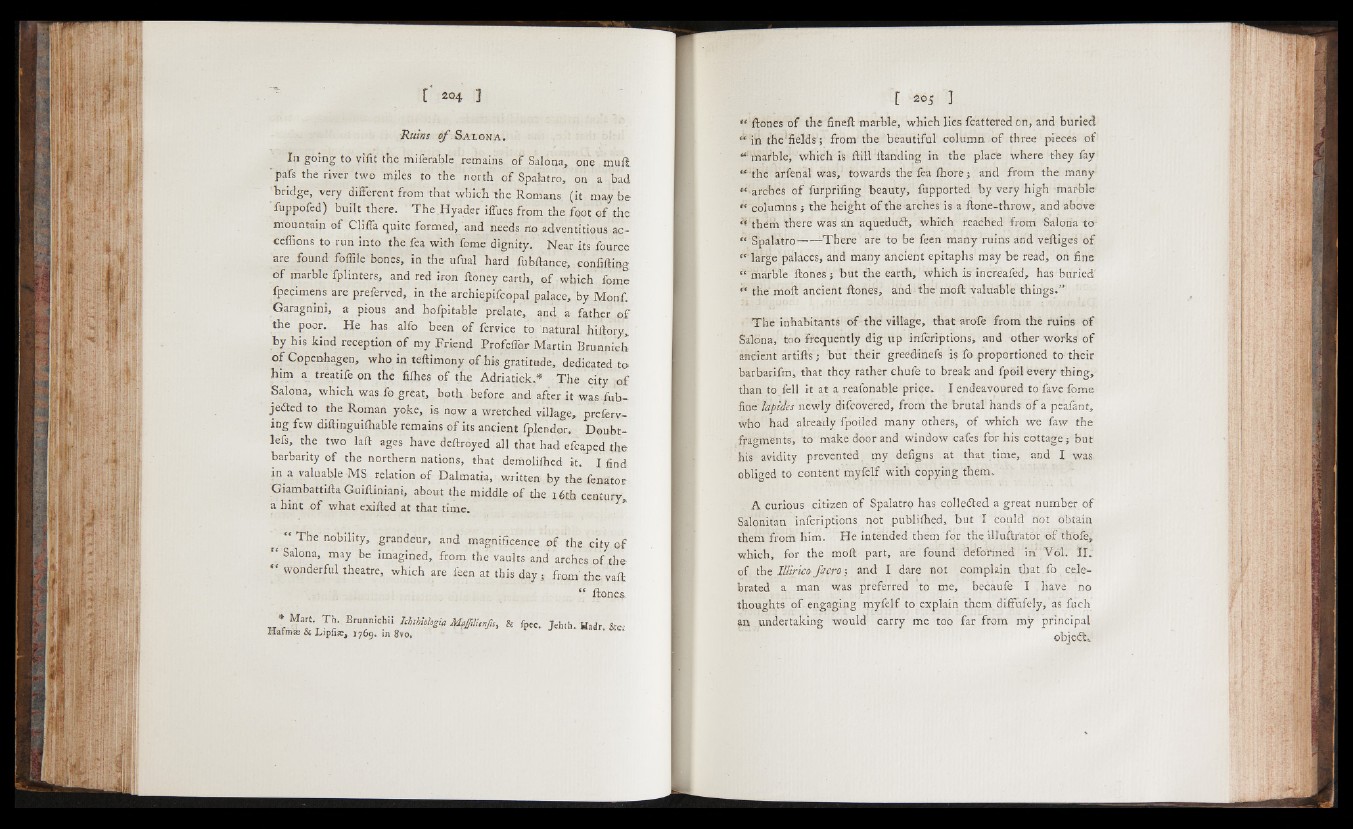
Ruins o f Sa io n a .
In going to vifit the miferable remains o f Saiona, one mull
'pafs the river two miles to the north o f Spalatro, on a bad
bridge, very diflerent from that which the Romans (it may be-
fuppofed) built there. The Hyader iffues from the foot o f the
mountain o f Cliffa quite formed, and needs no adventitious ac-
ceffions to run into the fea with fome dignity. Near its fouree:
are found foffile bones, in the ufual hard fubftance, confiding
o f marble fplinters, and red iron Roney earth, o f which fome
fpecimens are preferved, in the archiepifcopal palace, by Monf.
Garagnini, a pious and hofpitable prelate, and a father o f
the poor. He has alfo been o f fervice to natural hiftorv,
by his kind reception o f my Friend Profeffor Martin Brunnich
o f Copenhagen, who in teflimony of his gratitude, dedicated to
him a treatife on the fiihes o f the Adriatick.* The city o f
Saiona, which was fo great, both before and after it was fub-
jeifted to the Roman yoke, is now a wretched village, preferv-
ing few diflinguiihable remains o f its ancient fpfendor, Doubt-
lefs, the two laft ages have deilroyed all that had efcaped the
barbarity o f the northern nations, that demoliihed it. I find
m a valuable MS relation o f Dalmatia, written by the fenator
GiambattiAa GuiAiniani, about the middle o f the 16th century,
a hint o f what exifled at that time.
The nobility, grandeur, and magnificence o f the city of
' ‘ Saiona, may be imagined, from the vaults and arches of the
“ wonderful theatre, which are feen at this day; from the.vaR
“ Rones.
* Mart T h . Erunnichii I ,b th u h& B h H & fpee. J e h th .'Ib * . & «
fcUtmae & Lipiiie, 1769. in 8vo,
% Rones o f the fineR marble, which lies fcattered on, and buried
‘‘ in the'fields ; from the beautiful column o f three pieces o f
“ marble, which is Rill 'Handing in the place where they fay
“ the arfenal was,' towards the fea ihore; and from the many
“ arches o f furprifing beauty, fupported by very high marble
“ columns ; the height o f the arches is a Aone-throw, and above
therii there was' an aqueduft, which reached from Saiona to
“ Spalatro There are to be feen many ruins and veAiges o f
“ large palaces, and many ancient epitaphs may be read, on fine
“ marble Rones j but the earth, which is increafed, has buried'
1 the moR ancient Rones, and the moR valuable things.’'’
The inhabitants of the village, that arofe from the ruins o f
Saiona, too frequently dig up infcriptions, and other works o f
ancient artiAs; but their greedinefs is fo proportioned to their
barbarifm, that they rather chufe to break and fpoil every thing,
than to fell it at a reafonable price. I endeavoured to fave fome
fine lapides newly difcovered, from the brutal hands , o f a peafant,
who had already fpoiled many others, of which we faw the
fragments, to make door and window cafes for his cottage; but
his avidity prevented my defigns at that time, and I was,
obliged to content myfelf with copying them.
A curious citizen of Spalatro has colledted a great number o f
Salonitan infcriptions not .publiAied, but I could riot obtain
them from him. He intended them for the illuRrator of thofe,
which, for the moR part, are found deformed in Vol. II.
of the Illirico focra; and I dare not complain that fo celebrated
a man was preferred to me, becaufe I have no
thoughts o f engaging myfelf to explain them diffufely, as fuch
an undertaking would carry me too far from my principal
objedt.